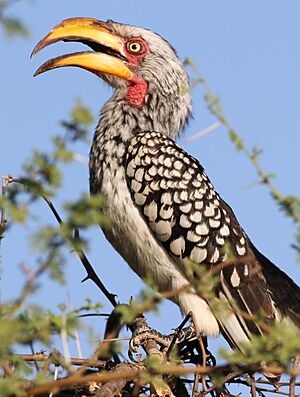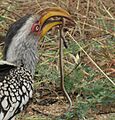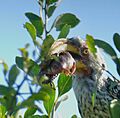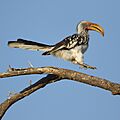Southern yellow-billed hornbill facts for kids
Quick facts for kids Southern yellow-billed hornbill |
|
|---|---|
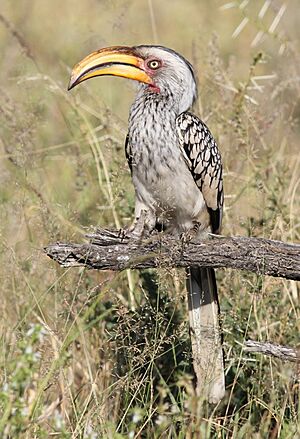 |
|
| Adult male of the nominate race in Mapungubwe N. P., South Africa | |
| Conservation status | |
| Scientific classification | |
| Genus: |
Tockus
|
| Species: |
leucomelas
|
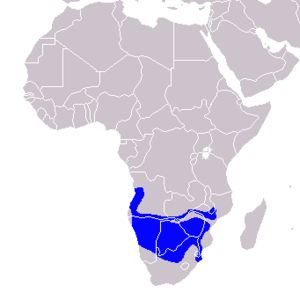 |
|
| resident range | |
The southern yellow-billed hornbill (Tockus leucomelas) is a type of hornbill bird. You can find it in southern Africa. These birds mostly look for food on the ground. They eat seeds, small insects, spiders, and even scorpions. This hornbill is very common in dry, thorny areas and woodlands with wide leaves. You might often spot them near roads and rivers.
Contents
About the Southern Yellow-billed Hornbill
This is a medium-sized bird. It is about 48 to 60 centimeters (19 to 24 inches) long. It weighs between 132 and 242 grams (0.3 to 0.5 pounds). A special feature is its long, yellow, and curved beak. This beak is very big compared to its body. It can be up to one-sixth of the bird's total length! Male hornbills have beaks that are about 90 millimeters (3.5 inches) long. Females have slightly shorter beaks, around 74 millimeters (2.9 inches) long. Males are usually bigger than females. The size of their beak is a good way to tell males and females apart in the wild.
What Does a Hornbill's Beak Look Like?
All hornbills have a special growth on top of their beak called a casque. For the southern yellow-billed hornbill, this casque is quite small. It covers almost the whole beak in males. In females, it covers less of the beak. This small casque might make it seem like they don't have one at all. Because their beak is so large, it can block some of the bird's front vision. Also, the first two bones in their neck are joined together.
Like most other hornbills, they have a long tail and long eyelashes. They also have short, strong legs and toes. The front three toes are joined together near the bottom.
Colors and Markings
These hornbills have a white belly and a gray neck. Their back is black with many white spots and stripes. The neck has gray spots, and the chest has light black lines. Southern yellow-billed hornbills only have black and white colors in their feathers. They don't have other colors. Their eyes are usually yellow, but some have brown eyes. The skin around their eyes and on their cheeks is pinkish. A similar bird, the eastern yellow-billed hornbill, has blackish skin around its eyes.
Where They Live
These birds mostly live in the dry savannas of southern Africa. You can find them from Angola and Namibia in the west. They also live in Mozambique and KwaZulu-Natal in the east. This includes countries like Botswana, Zimbabwe, and northern South Africa.
The southern yellow-billed hornbill prefers dry, open savannas. But they also like woodlands when they can find them. In woodlands, they seem to prefer acacia trees and broad-leaved trees. The most hornbills have been seen in open mopane scrub areas.
How They Behave
Southern yellow-billed hornbills are active in the morning, during the day, and in the evening. At night, they sleep high in a tree to stay safe from predators. You might see them alone, in pairs, or in small groups. They usually prefer to be alone. But they gather in groups during breeding season, nesting season, or when they move to find food in the dry season.
You often see these hornbills looking for food on the ground or in bushes. They don't dig in the ground. Instead, they turn over leaves and other things to find insects. They might also hop quickly to catch insects.
These birds usually stay in one place. They protect their areas with special displays. However, in the dry season, they sometimes travel far to find food. Pairs of hornbills are usually together for life. The male and female share tasks clearly.
In zoos, they have been known to live for up to 20 years. We don't know how long they live in the wild.
How They Fly
The southern yellow-billed hornbill flies with strong wing beats. They fly by flapping their wings hard, then gliding for short periods. These hornbills do not have special feathers under their wings. This helps air flow better when they fly.
What Sounds They Make
Southern yellow-billed hornbills have a loud, piercing cry. But they can make many other sounds too. These include whistling, grunting, and cackling sounds. They use their loud calls to mark their territory or to talk to other hornbills far away. Like other Tockus hornbills, they often make physical displays while calling.
What They Eat
Southern yellow-billed hornbills mainly eat arthropods. These are creatures like insects and spiders. They especially like termites, beetles, and their larvae. They also eat grasshoppers and caterpillars. Sometimes, they eat centipedes and scorpions. They might even eat small mammals if they can catch them. To complete their diet, they regularly eat berries, fruits, nuts, and eggs from other birds.
Hornbills use their beaks like a pair of tweezers. They grab food with the tips of their beaks. Then they toss the food back into their throat. A short, strong tongue helps them swallow the food. The inside edges of their beak are rough. This helps them crush and break up food. Most of their food is picked from the ground or from low plants. Their diet is similar to that of the southern ground hornbill.
Reproduction and Life Cycle
The breeding season starts when the first autumn rains fall. This usually happens from September to March. Most eggs are laid between October and December. Eggs are laid during the wet season. So, the peak time for laying eggs changes depending on when the rainy season is in different areas. For example, in eastern areas, the peak is usually from November to February. In the northwest, it's from December to March. These times match when it rains the most.
Young birds can start having their own babies when they are one year old. Before they actually breed, the male feeds the female as a courtship ritual. They also preen each other (clean feathers). And they look for good places to build a nest.
Once a male southern yellow-billed hornbill has found a mate, he stays with her. He sets up an area that he will protect. Nests are built in natural holes in trees, cliffs, or earth banks. They are usually between 1 and 12 meters (3 to 39 feet) off the ground. The male brings bark, leaves, and grass to line the bottom of the nest. During this time, the female seals herself inside the nest. She blocks the entrance with a wall made from her droppings and leftover food. The male helps by bringing mud for her to use.
Only a narrow vertical slit is left open. The male passes food through this slit with his beak. The female and chick droppings are also pushed out through this slit. The slit allows good air to flow through the nest. This, along with the wooden walls, keeps the nest well insulated.
Nests usually have 2 to 6 eggs. The eggs take about 24 days to hatch. The eggs are white, oval, and have slightly rough shells. The chicks are born without feathers and have pink skin. The male feeds both the female and the chicks by dropping food through the slit. Most nests also have a long escape tunnel. This is in case a predator tries to break into the nest.
While she is sealed inside, the female loses all her flight and tail feathers at once. She regrows them during the time she stays with the chicks. Once the chicks are about half-grown, the female breaks out of the nest. She then helps the male find food. The chicks rebuild the wall themselves. They continue to be fed through the slit by their parents. Once the chicks are fully grown, they break out of the nest and start to fly.
Hornbills and People
Hornbills have a very unique look. Because of this, many cultures see them as important in their beliefs. Some native tribes respect hornbills as sacred animals. They believe these birds should not be harmed. Other people might hunt them for food. They also use them to make traditional medicine or in special ceremonies.
Images for kids
-
Immature bird at Kruger Park, South Africa
-
With caterpillar prey, eastern South Africa
-
With small snake prey, Kruger Park
-
Roving party in the non-breeding season, Etosha
-
Hopping gait on tree limb, Marakele



